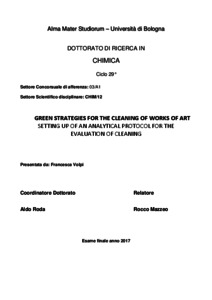Volpi, Francesca
(2017)
Green Strategies for the Cleaning of Works of Art Setting Up of an Analytical Protocol for the Evaluation of Cleaning, [Dissertation thesis], Alma Mater Studiorum Università di Bologna.
Dottorato di ricerca in
Chimica, 29 Ciclo. DOI 10.6092/unibo/amsdottorato/8050.
Documenti full-text disponibili:
![[img]](http://amsdottorato.unibo.it/8050/1.hassmallThumbnailVersion/PhD%20thesis%20FV_2017_k.pdf)  Anteprima |
|
Documento PDF (English)
- Richiede un lettore di PDF come Xpdf o Adobe Acrobat Reader
Disponibile con Licenza: Salvo eventuali più ampie autorizzazioni dell'autore, la tesi può essere liberamente consultata e può essere effettuato il salvataggio e la stampa di una copia per fini strettamente personali di studio, di ricerca e di insegnamento, con espresso divieto di qualunque utilizzo direttamente o indirettamente commerciale. Ogni altro diritto sul materiale è riservato.
Download (4MB)
| Anteprima
|
Abstract
In last decades, the safety of both artworks and restorers during cleaning operations, has been the subject of many research works, aimed at the development of gel-systems that confine the solvent action to the very surface thus preventing its absorption into the paint layers and minimizing operators’ exposure.
In this research work, a totally sustainable approach has been presented for the cleaning of artworks. In particular new organogels made of bio-compatible components, were evaluated as cleaning tool for the removal of paint varnishes. The gels consist of a polymer derived from renewable bio-materials, poly(-3hydroxybutyrrate), and different green solvents (γ-valerolactone GVL, ethyl lactate EL, dimethyl carbonate DMC). These gels, previously characterized in order to investigate thermal and mechanical properties, were tested for the removal of natural and acrylic varnishes over different binding medium (linseed oil, egg and glue).The gels were first tested on painting mock-ups, not aged and aged, then validated on real paintings. Their cleaning capabilities were compared to methods traditionally employed in restoration (e.g. dimethyl sulfoxide, benzyl alcohol acetone, carbopol-gel). A specific protocol of cleaning evaluation was designed for assessing varnish removal capability, residues releasing and solvent retention by means of Optical Microscope observations of paint cross sections in visible and ultraviolet light, µFTIR-Attenuated Total Reflection surface analyses and Head Space-Solid Phase Micro Extraction coupled with GC-MS analyses. These new totally safe and biodegradable organogels demonstrated good varnish cleaning capabilities that, in conjunction with their easy preparation, use and waste, represent a “green” and safe approach for both paintings and painting restorers.
Abstract
In last decades, the safety of both artworks and restorers during cleaning operations, has been the subject of many research works, aimed at the development of gel-systems that confine the solvent action to the very surface thus preventing its absorption into the paint layers and minimizing operators’ exposure.
In this research work, a totally sustainable approach has been presented for the cleaning of artworks. In particular new organogels made of bio-compatible components, were evaluated as cleaning tool for the removal of paint varnishes. The gels consist of a polymer derived from renewable bio-materials, poly(-3hydroxybutyrrate), and different green solvents (γ-valerolactone GVL, ethyl lactate EL, dimethyl carbonate DMC). These gels, previously characterized in order to investigate thermal and mechanical properties, were tested for the removal of natural and acrylic varnishes over different binding medium (linseed oil, egg and glue).The gels were first tested on painting mock-ups, not aged and aged, then validated on real paintings. Their cleaning capabilities were compared to methods traditionally employed in restoration (e.g. dimethyl sulfoxide, benzyl alcohol acetone, carbopol-gel). A specific protocol of cleaning evaluation was designed for assessing varnish removal capability, residues releasing and solvent retention by means of Optical Microscope observations of paint cross sections in visible and ultraviolet light, µFTIR-Attenuated Total Reflection surface analyses and Head Space-Solid Phase Micro Extraction coupled with GC-MS analyses. These new totally safe and biodegradable organogels demonstrated good varnish cleaning capabilities that, in conjunction with their easy preparation, use and waste, represent a “green” and safe approach for both paintings and painting restorers.
Tipologia del documento
Tesi di dottorato
Autore
Volpi, Francesca
Supervisore
Dottorato di ricerca
Ciclo
29
Coordinatore
Settore disciplinare
Settore concorsuale
Parole chiave
green, cleaning, PHA, gel, painting, artwork, varnish
URN:NBN
DOI
10.6092/unibo/amsdottorato/8050
Data di discussione
3 Maggio 2017
URI
Altri metadati
Tipologia del documento
Tesi di dottorato
Autore
Volpi, Francesca
Supervisore
Dottorato di ricerca
Ciclo
29
Coordinatore
Settore disciplinare
Settore concorsuale
Parole chiave
green, cleaning, PHA, gel, painting, artwork, varnish
URN:NBN
DOI
10.6092/unibo/amsdottorato/8050
Data di discussione
3 Maggio 2017
URI
Statistica sui download
Gestione del documento:


 Login
Login
